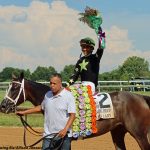PIASSEK: More time a must for Preakness – and Belmont
One of the rites of spring for racing fans is the annual Triple Crown debate. Should the schedule be changed? What about the distances? Would any horse who wins the Triple Crown in the future need an asterisk? On and on and on.
The debate has reached a fever pitch over the last two years, as more and more trainers treat the Preakness Stakes and the Belmont Stakes as afterthoughts. Last year, Kentucky Derby winner Rich Strike bypassed the Preakness, in favor of waiting an extra five weeks for the Belmont. Only three horses who ran in the Derby also competed in the Preakness, and of the nine Preakness starters, a mere two pressed on to the Belmont three weeks later. Neither of the top two Preakness finishers nor any of the Derby-Preakness starters contested the Belmont.
This year, the situation got even more urgent. Kentucky Derby winner Mage did contest the Preakness, but did so only after five days of hemming and hawing from his connections. He was the only Derby horse to run in the Preakness, making for the smallest Preakness field since 1986. Outside of Mage, it was a field that looked more like the Ohio Derby or Monmouth’s Pegasus Stakes than the Preakness.
Three weeks later at the Belmont Stakes, only two Preakness runners, neither of whom was Mage, entered the starting gate. Just three Derby runners showed up, meaning that of the 18 horses in this year’s Run for the Roses, 14 did not run in the Preakness or the Belmont. Last year, it was a similar story: 20 horses entered the Derby starting gate, and 14 of them did not run in another leg of the Triple Crown.
It’s clear that the Triple Crown as a series is completely broken.
In years past, the best 3-year-olds sought to contest as many legs of the series as they could, regardless of how well they did in the Derby. Horses like Bet Twice, Easy Goer, and Victory Gallop lost the Derby and the Preakness, but rebounded to win the Belmont. Following Derby losses, Hansel, Tabasco Cat, Point Given, and Afleet Alex swept the Preakness and the Belmont.
CHECK OUT THE LATEST OFF TO THE RACES RADIO!
Would any of those horses have run in the last two legs today? Or even one of the two?
Of course, there were year-to-year aberrations where a leg of the series would attract a small field, or lack star power, but it’s certainly become a lot more common now. Trainers single-mindedly point their charges to the Derby, and hardly consider the Preakness or the Belmont with their A-team horses. When you hear someone call a horse a possible Preakness horse or Belmont horse, it’s almost derogatory.
And as the Derby becomes more all-consuming, the other legs begin to suffer. Each of the last two years, neither the Preakness nor the Belmont attracted ten horses to the starting gate. The Belmont, in fact, has had single-digit fields three straight years. The last middle and final jewels both were under 10 runners prior was 2015, American Pharoah’s year. There was hardly an American Pharoah in either of the previous two year’s crops. The last time before Pharoah was 2007, and before then, it was 1988.
Over the course of the past few weeks, many racing fans on social media have defended the current iteration of the Triple Crown, saying the supposedly sacrosanct schedule cannot be changed in the name of tradition and challenges or whatever. But they should ask themselves, did they enjoy watching Mage and a bunch of B and C-team 3-year-olds in the Preakness? Do they get a kick out of news item after news item announcing a top 3-year-old is skipping the Preakness and the Belmont? Are we getting the best possible fields in either of those races?
If you’re a national racing fan, maybe you’re not as invested in the Preakness or the Belmont as you are in the Derby. And that’s fine. But for someone like me, with a year-round stake in Maryland racing, it’s important for the local industry — and for the racing industry as a whole — that the Preakness starts attracting top 3-year-olds again.
Recently, Fred Pope wrote a letter to the editor in the Thoroughbred Daily News suggesting that the Preakness be moved to April, ahead of the Derby. While I’m sure he means well, such an idea would make the Preakness even more irrelevant. Short of a massive purse bump (which may further dilute the undercard stakes), what would make the Preakness so interesting compared to other preps? It would go head-to-head against races like the Florida Derby and the Arkansas Derby, races that exist only in the shadow of the First Saturday in May. If anything, if it’s two or three weeks before the Derby, as Pope suggested, that would make it too close to the Derby to get any major 3-year-old. You’d have the same problems attracting top horses as now, only in colder weather.
And if you think it being a Triple Crown race would make it more appealing to owners and trainers, well, owners and trainers don’t care about the Triple Crown now! If they have other big-money options to get their horses ready for the Derby, the lure of winning a jewel of the Triple Crown will not distract them.
Two Phil’s, for example, would have been a major contender in either the Preakness or the Belmont. But his connections have opted for the $500,000, Grade 3 Ohio Derby, where he’s 8-5 on the morning line and likely goes off shorter than that. The lure of the easier route to a smaller but still substantial payday proved irresistible.
Earlier this year I suggested via tweet that the legs of the Triple Crown be moved to the first Saturdays of each month (i.e. Derby first Saturday in May, Preakness first Saturday in June, Belmont first Saturday in July). It met with pushback from some people, mainly those whose lives will be the same regardless of how many Derby horses show up for the Preakness, but I stand by the idea as a way forward for the series. If you mix it with a point system and bonuses for the top earners in all three races, you might have something promising.
Would it be a magic bullet? No. Do Pimlico and Belmont Park make enough money with the current schedule? Probably. But spreading out the Triple Crown races a bit more, and pushing the Preakness and the Belmont further behind the Derby, not ahead, may incentivize trainers to get their horses ready for the entire series, rather than just one race.
All parties – and the sport as a whole — would benefit from three strong races, rather than just one, and as long as trainers are uninterested in running their horses three times in five weeks, extra spacing is a must for a thriving Preakness and Belmont.
LATEST NEWS















